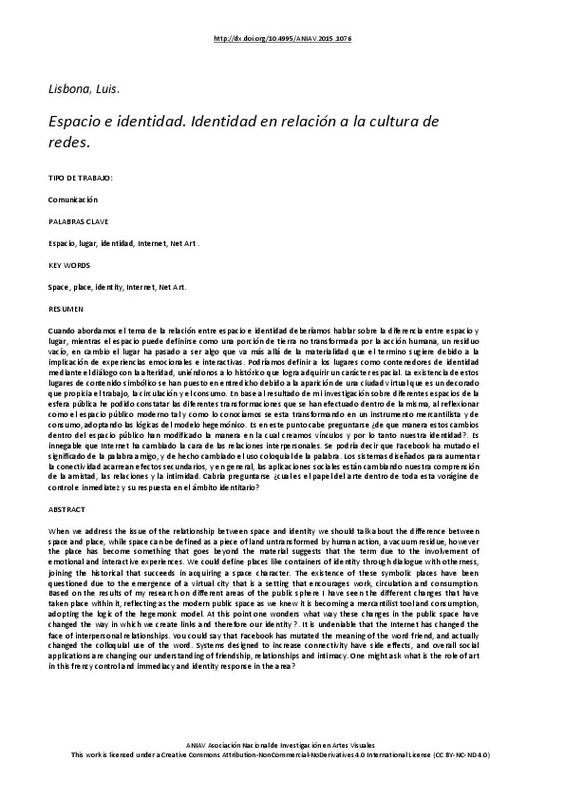JavaScript is disabled for your browser. Some features of this site may not work without it.
Buscar en RiuNet
Listar
Mi cuenta
Estadísticas
Ayuda RiuNet
Admin. UPV
Espacio e Identidad. Identidad en relación a la cultura de redes
Mostrar el registro sencillo del ítem
Ficheros en el ítem
| dc.contributor.author | Ortega Lisbona, José Luis
|
es_ES |
| dc.date.accessioned | 2018-02-13T11:13:41Z | |
| dc.date.available | 2018-02-13T11:13:41Z | |
| dc.date.issued | 2015-11-26 | |
| dc.identifier.isbn | 9788490483411 | |
| dc.identifier.uri | http://hdl.handle.net/10251/97812 | |
| dc.description.abstract | [EN] When we address the issue of the relationship between space and identity we should talk about the difference between space and place, while space can be defined as a piece of land untransformed by human action, a vacuum residue, however the place has become something that goes beyond the material suggests that the term due to the involvement of emotional and interactive experiences. We could define places like containers of identity through dialogue with otherness, joining the historical that succeeds in acquiring a space character. The existence of these symbolic places have been questioned due to the emergence of a virtual city that is a setting that encourages work, circulation and consumption. Based on the results of my research on different areas of the public sphere I have seen the different changes that have taken place within it, reflecting as the modern public space as we knew it is becoming a mercantilist tool and consumption, adopting the logic of the hegemonic model. At this point one wonders what way these changes in the public space have changed the way in which we create links and therefore our identity ?. It is undeniable that the Internet has changed the face of interpersonal relationships. You could say that Facebook has mutated the meaning of the word friend, and actually changed the colloquial use of the word. Systems designed to increase connectivity have side effects, and overall social applications are changing our understanding of friendship, relationships and intimacy. One might ask what is the role of art in this frenzy control and immediacy and identity response in the area? | es_ES |
| dc.description.abstract | [ES] Cuando abordamos el tema de la relación entre espacio e identidad deberíamos hablar sobre la diferencia entre espacio y lugar, mientras el espacio puede definirse como una porción de tierra no transformada por la acción humana, un residuo vacío, en cambio el lugar ha pasado a ser algo que va más allá de la materialidad que el termino sugiere debido a la implicación de experiencias emocionales e interactivas. Podríamos definir a los lugares como contenedores de identidad mediante el diálogo con la alteridad, uniéndonos a lo histórico que logra adquirir un carácter espacial. La existencia de estos lugares de contenido simbólico se han puesto en entredicho debido a la aparición de una ciudad virtual que es un decorado que propicia el trabajo, la circulación y el consumo. En base al resultado de mi investigación sobre diferentes espacios de la esfera pública he podido constatar las diferentes transformaciones que se han efectuado dentro de la misma, al reflexionar como el espacio público moderno tal y como lo conocíamos se esta transformando en un instrumento mercantilista y de consumo, adoptando las lógicas del modelo hegemónico. Es en este punto cabe preguntarse ¿de que manera estos cambios dentro del espacio público han modificado la manera en la cual creamos vínculos y por lo tanto nuestra identidad?. Es innegable que Internet ha cambiado la cara de las relaciones interpersonales. Se podría decir que Facebook ha mutado el significado de la palabra amigo, y de hecho cambiado el uso coloquial de la palabra. Los sistemas diseñados para aumentar la conectividad acarrean efectos secundarios, y en general, las aplicaciones sociales están cambiando nuestra comprensión de la amistad, las relaciones y la intimidad. Cabria preguntarse ¿cual es el papel del arte dentro de toda esta vorágine de control e inmediatez y su respuesta en el ámbito identitario? | es_ES |
| dc.format.extent | 7 | es_ES |
| dc.language | Español | es_ES |
| dc.publisher | Editorial Universitat Politècnica de València | es_ES |
| dc.relation.ispartof | II CONGRESO INTERNACIONAL DE INVESTIGACIÓN EN ARTE VISUALES | es_ES |
| dc.rights | Reconocimiento - No comercial - Sin obra derivada (by-nc-nd) | es_ES |
| dc.subject | Espacio | es_ES |
| dc.subject | Lugar | es_ES |
| dc.subject | Identidad | es_ES |
| dc.subject | Internet | es_ES |
| dc.subject | Net Art | es_ES |
| dc.title | Espacio e Identidad. Identidad en relación a la cultura de redes | es_ES |
| dc.type | Capítulo de libro | es_ES |
| dc.type | Comunicación en congreso | es_ES |
| dc.identifier.doi | 10.4995/ANIAV.2015.1076 | |
| dc.rights.accessRights | Abierto | es_ES |
| dc.contributor.affiliation | Universitat Politècnica de València. Departamento de Escultura - Departament d'Escultura | es_ES |
| dc.description.bibliographicCitation | Ortega Lisbona, JL. (2015). Espacio e Identidad. Identidad en relación a la cultura de redes. En II CONGRESO INTERNACIONAL DE INVESTIGACIÓN EN ARTE VISUALES. Editorial Universitat Politècnica de València. 390-396. https://doi.org/10.4995/ANIAV.2015.1076 | es_ES |
| dc.description.accrualMethod | OCS | es_ES |
| dc.relation.conferencename | II Congreso Internacional de Investigación en Artes Visuales. |< real | virtual >| ANIAV2015 | es_ES |
| dc.relation.conferencedate | July 09-10,2015 | es_ES |
| dc.relation.conferenceplace | Valencia, Spain | es_ES |
| dc.relation.publisherversion | http://ocs.editorial.upv.es/index.php/ANIAV/ANIAV2015/paper/view/1076 | es_ES |
| dc.description.upvformatpinicio | 390 | es_ES |
| dc.description.upvformatpfin | 396 | es_ES |
| dc.type.version | info:eu-repo/semantics/publishedVersion | es_ES |
| dc.relation.pasarela | OCS\1076 | es_ES |








